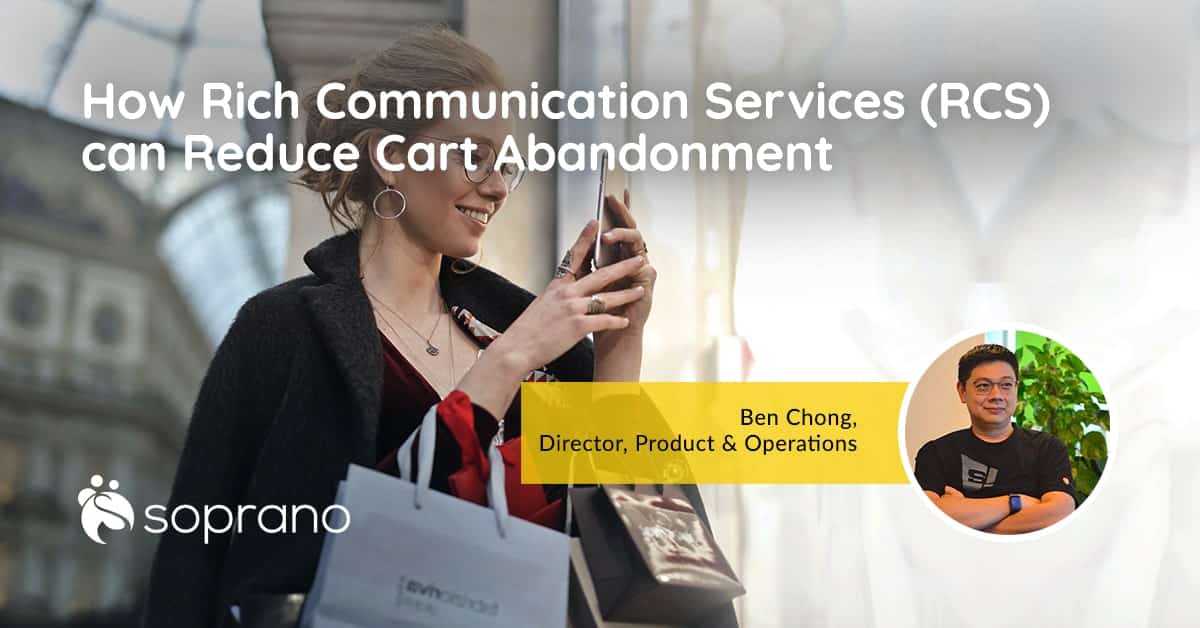How to Reduce Cart Abandonment Rate with RCS

The abandoned cart is a very modern business problem. Sure, you might see a half-full cart sitting alone in the supermarket every now and again, but with e-commerce experiences consisting of just a handful of clicks, and comparison shopping able to be done in seconds, it’s little surprise that many online businesses currently face an abandoned cart epidemic.
Cart abandonment refers to when a customer starts the check-out process, but leaves before completing the transaction. There are many factors that contribute to cart abandonment, and there are therefore many potential fixes.
Here I’d like to take a look at cart abandonment through the lens of rich communication services, or RCS. Upgrading to RCS can open up a whole new world of customer communication for your business, which can prove key in converting as many carts as possible.
The role of RCS in customer engagement
What is RCS? It can be thought of as the evolution of text messaging: a way to bring SMS into the modern world, giving it the features that you see on apps like Facebook Messenger, WhatsApp, Viber and WeChat. As with SMS, RCS lives as a native app on all new Android phones, and allows users to do things like send large files, make payments, and connect to software through APIs.
RCS is a more complete business communication solution, as it offers all the features and usability of modern messaging apps, but doesn’t require a user to download anything – it’s right there, on all new Android phones, ready to be used. This creates greater standardization, which facilitates a more familiar and intuitive customer experience, all while opening up a whole new world of business communication potential, which many organizations are preparing to use to their advantage.
The recently announced RCS Universal Profile V2.0 has seen an industry-agreed set of features and technical enablers developed to simplify the product development and global operator deployment of RCS. These features provide interoperability and guidelines for mobile software developers to build RCS services like business messaging, rich cards, privacy controls, and spam protections.
When it’s used well, RCS looks set to have a real impact on cart abandonment rates. Before we dig into the detail, let’s first look a little closer at the issue at hand.
Why are carts abandoned in the first place?
One of the most common reasons for cart abandonment is process complexity. If the purchase process has too many steps and takes too long to complete, it’s far more likely to be abandoned. The process must be simple, relevant, and feature an intuitive user interface.
Chatbots can be helpful in guiding a customer through the purchase process, but they need to be used in the right way. If a bot can’t answer a customer’s question, there needs to be a fallback option to continue the conversation with a human. That human also needs to have access to the conversation that the customer had with the bot, to ensure that the same questions aren’t asked again.
Process complexity aside, some of the biggest reasons customers abandon their carts in e-commerce include:
- They’re window shopping with no immediate intent to buy
- Price comparison – products are cheaper elsewhere
- The user is unfamiliar with the interface and finds it unintuitive
- Technical issues
- Limited payment options
As mentioned above, the same abandonment trends are also seen in customer service. Some of the most common reasons include:
- An inability to solve the customer’s problem
- No option for customers to switch to live conversation
- Repetitive questions
- Answers being too general and vague
How RCS can reduce cart abandonment and drive sales
Now that we know what RCS is, and the main issues that surround cart abandonment, how can the former address the latter?
There might be a temptation to use RCS to prompt a customer to revisit their cart and complete a transaction. But such a direct approach can be quite annoying, to the point that it might be considered spam (not to mention such close tracking of customer behaviors could violate privacy policies.)
A better approach is to let the customer decide when they’re ready to revisit their cart, and use RCS from there. When they return to your site, RCS could be used to remind the customer of their abandoned cart, and provide the option to continue with that purchase, or empty the cart and start again. If purchases are made, RCS could also be used to obtain feedback, which you can use to improve your processes into the future.
RCS allows a business to communicate with its customers in a secure, feature-rich and interactive way. It supports third-party APIs, transforming it from a communication channel to a vibrant and totally customizable application. If you make your entire technology ecosystem RCS-enabled, including merchant POS, entry points and payment channels, you’ll be well placed to offer the sort of experiences that customers are increasingly looking for, and that most of your competitors are so far failing to create.
There’s no doubt that RCS represents the future of B2C communication. The question now is whether you’re going to prepare yourself for what’s to come. If the answer is ‘yes’, here’s RCS Messaging.